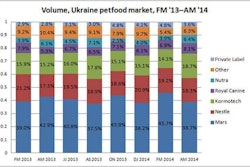While experts are forecasting a record-plus year for crop yields, an abundant harvest does not always indicate a problem-free crop to feed to livestock, and preliminary data conducted by Alltech’s 37+ Mycotoxin Analysis Program is showing there might be issues to watch for.
Late season rains have slowed harvest across the Midwest US. As of Oct. 27, 2014, the US Department of Agriculture (USDA) estimated the corn harvest at 46%, a 15% increase from the previous week but 19% behind the five-year average. Corn conditions were estimated by the USDA at 74% “good” or “excellent” condition, 19% was considered “fair” and 7% was considered “poor.” While these initial condition ratings look favorable, experts warn that seasonal conditions still might have taken a toll on the crop and left behind some masked mycotoxins.
“Cool, wet weather can be a precursor for mold growth and can lead to possible mycotoxin issues,” said Dr. Max Hawkins, nutritionist with Alltech’s Mycotoxin Management Team. “Fusarium graminareum can produce a variety of mycotoxins and prefers high moisture and temperatures from 59 to 85 degrees Fahrenheit. This year’s growing season was cool and wet and the harvest season has also been delayed by wet weather."
An early indication of the Fusarium issue was found in the wheat crop, where high levels of Deoxynivalenol (DON) were found east of the Mississippi River, Dakotas and into Canada. DON levels in these regions ranged from 1,000 ppb to 15,000 ppb. According to Hawkins, this places wheat at a potential high risk for livestock feed, and extreme caution should be used when feeding straw to ruminants.
Corn silage samples have also indicated there might be challenges in the 2014 crop. “The 2014 corn season started off slow due to wet planting conditions and cool soil temperatures," said Heath Paradice, technical manager for Alltech Crop Science. "As a result, while some corn was planted in April, most was done in early to mid-May and in some cases like northern Iowa, planting extended into June. The late planted crops are doing better than expected due to a late fall, but that corn is coming in at a higher moisture content."
The first 35 corn silage samples analyzed at the recently ISO/IEC 17025:2005 accredited Analytical Services Laboratory of Alltech using Alltech’s 37+ analysis contained an average of 6.83 mycotoxins per sample. Further analysis showed that Type B Trichothecenes, DON and other DON group mycotoxins had an average/sample of 2,087 ppb. Fusaric acid, which can act synergistically with DON, had an average/sample of 1,322 ppb. “Combined, these mycotoxins can have a significant impact on dry matter intake, milk production, growth rate, feed efficiency, gut health, organ function and immune response,” said Hawkins.
With an average/sample level of 126.7 ppb, Zearalenone is showing levels higher than in the past two years. Other Penicilliums, which can impact gut health and rumen function, are typically referred to as “storage mycotoxins” as they require little oxygen and can flourish rapidly in stored forages. Hawkins said the 2014 crop has had some relatively high Penicillium levels already at harvest.
Corn that is stressed and damaged by weather events and insects is more susceptible to mycotoxins. While walking fields and looking for signs of molds, ear rot and stalk rot can be indicators for mycotoxins, there can be toxins present with no visible mold. Hawkins said he recommends having samples analyzed for mycotoxins. “The outlook for corn grain is concerning as the crop has been subjected to a later harvest with increased rain while still in the field,” said Hawkins. “The crop may be harvested at higher moisture levels, which can put added pressure on drying and storage environment to ensure grain at 15% moisture or less for long term storage."













